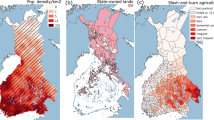ABSTRACT
Human land-use activities differ from natural disturbance processes and may elicit novel biotic responses and disrupt existing biotic-environmental relationships. The widespread prevalence of land use requires that human activity be addressed as a fundamental ecological process and that lessons from investigations of land-use history be applied to landscape conservation and management. Changes in the intensity of land use and extent of forest cover in New England over the past 3 centuries provide the opportunity to evaluate the nature of forest response and reorganization to such broad-scale disturbance. Using a range of archival data and modern studies, we assessed historical changes in forest vegetation and land use from the Colonial period (early 17th century) to the present across a 5000 km2 area in central Massachusetts in order to evaluate the effects of this novel disturbance regime on the structure, composition, and pattern of vegetation and its relationship to regional climatic gradients. At the time of European settlement, the distribution of tree taxa and forest assemblages showed pronounced regional variation and corresponded strongly to climate gradients, especially variation in growing degree days. The dominance of hemlock and northern hardwoods (maple, beech, and birch) in the cooler Central Uplands and oak and hickory at lower elevations in the Connecticut Valley and Eastern Lowlands is consistent with the regional distribution of these taxa and suggests a strong climatic control over broad-scale vegetation patterns. We infer from historical and paleoecological data that intensive natural or aboriginal disturbance was minimal in the Uplands, whereas infrequent surface fires in the Lowlands may have helped to maintain the abundance of central hardwoods and to restrict the abundance of hemlock, beech, and sugar maple in these areas. The modern vegetation is compositionally distinct from Colonial vegetation, exhibits less regional variation in the distribution of tree taxa or forest assemblages defined by tree taxa, and shows little relationship to broad climatic gradients. The homogenization of the vegetation, disruption of vegetation-environment relationships, and formation of new assemblages appear to be the result of (a) a massive, novel disturbance regime; (b) ongoing low-intensity human and natural disturbance throughout the reforestation period to the present; (c) permanent changes in some aspects of the biotic and abiotic environment; and (d) a relatively short period for forest recovery (100–150 years). These factors have maintained the regional abundance of shade intolerant and moderately tolerant taxa (for example, birch, red maple, oak, and pine) and restricted the spread and increase of shade-tolerant, long-lived taxa such as hemlock and beech. These results raise the possibility that historical land use has similarly altered vegetation-environment relationships across broader geographic regions and should be considered in all contemporary studies of global change.
Similar content being viewed by others
Author information
Authors and Affiliations
Additional information
Received 5 May 1997; accepted 5 August 1997.
Rights and permissions
About this article
Cite this article
Foster, D., Motzkin, G. & Slater, B. Land-Use History as Long-Term Broad-Scale Disturbance: Regional Forest Dynamics in Central New England. Ecosystems 1, 96–119 (1998). https://doi.org/10.1007/s100219900008
Issue Date:
DOI: https://doi.org/10.1007/s100219900008




